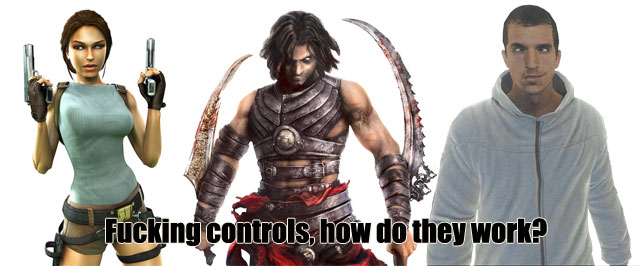
Not there! Run on the wall! Not up the wall, along it! Why the fuck have you not grabbed it?! Left! Left, you shit!!Welcome to the world of acrobatic action adventure and platforming games of the last 10 years, baby.
Original Prince of Persia was released in 1989 and instantly became a template for new platforming genres. Prince’s agility and tricks became a standard. And, along with beautiful animations, one of the important elements of its success was the permanence of rules. Player could always tell by eye if he can make the jump, when he can outrun the closing gates, when the fall will kill him. This simple set of rules was especially easy to follow in the game’s two dimensions. But then 3D became popular and rules had to change.
Probably, the best and definitely the most popular successor of PoP was Tomb Raider. It followed the original formula and even the original move list, adding only swimming and item collection (also, a female lead, which was still very rare in gaming). It tried to utilize three dimensions to enhance the game, not to frustrate the player with needless gimmick. And every TR game after it (till Legend) used the same successful formula of simple and permanent rules from PoP. You could still know if you can make the jump, if you will be able to grab the ledge, since the only surface you couldn’t grab was a flat wall. “Tank” controls, dependent not on camera angle, but on which way the character is facing, made the gameplay slower, yet more precise. You will run in a straight line and make the jump, even if the camera decides to change the angle. But with the beginning of 00-s and the desire to make games faster and “cinematic” came the next change.
The first herald of this change was, ironically, again Prince of Persia. Sands of Time changed players’ perception of what acrobatics and platforming should look like in action adventure games. More agile, with new tricks under his sleeve (wall run, for example), but with the old concept of rule simplicity and permanence. In Sands of Time it’s rather hard to notice the change between the “permanent” acrobatics to “context sensitive” ones, because of the ingenious design. One cannot check if the acrobatics works the same way throughout the game if there is no opportunity to notice this change. But the seed of context sensitive change was planted.
I will skip all the changes through the last 10 years you probably know yourselves, with just saying how an “honest” acrobatics turned into a “cinematic” one. Your character jumped the same distance in older Tomb Raider games? Now you can’t! Embrace the progress. And the funniest thing is, that in creating the randomness element in the acrobatics (adding to player’s frustration), making it that player never knows for sure what the character he is supposedly controlling will do, and, thus, creating a new problem in the design, developers decided to throw out the magic wand of the old design – the ability to save when you want. Looking back at Tomb Raider: every classic game in the series (excluding the console release of the first and third one), where you could fail only by your own mistake or chunkiness of the controls, you could save at any time. You could restart at that last tricky jump in the long ascent, where falling down doesn’t mean death, but another try. And this ability with retarded ease was discarded in the modern games, where your failure depends on “camera trying to be helpful” much more than on your actions.
How to fix it? There was one wonderful and underrated game, released last year, called Enslaved: Odyssey to the West, where you can see one of the ways to fix the current situation. So if you, dear developer, want to create random platforming rules in your game so much, than, please, make it so i can’t make a wrong jump at all. Failing because of one’s mistake is understandable (and great, as we learn on mistakes). Failing because of camera, or, what is even more frustrating, because you jump through the object your character was supposed to grab onto (since the context sensitiv script decided that you were in the wrong place)… Grrr! That’s not a challenge, that’s bad game design.
Another solution can be in, surprise, return to the older working set of rules. You don’t have to return the tank controls and the slow pace. You just have to make platforming work the same way throughout the entire game. And not making lazy “platforming puzzles” which wouldn’t even be puzzles with “honest” platforming.
I’m sure, there are more, and probably better, solutions to this problem. And developers should search for them, because the current situations with such games is scary. I’m the cool treasure hunter who just died by jumping to the left instead of up. I’m the cunning and deadly assassin who just decided to sit on the bench instead of climbing up the building. I’m the three-eyed spy, who would really like to twist your neck, but unfortunately i happened to hide under the table instead of climbing into an air-duct (i’ll twist your ankle instead). “What a bunch of misfits, ” – thinks Monkey as he climbs up on the roof, where old Lara, pixelated Prince and tired Abe wait.